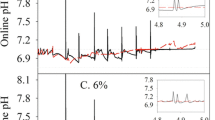Abstract
The concentration effects of certain amino acids (Asp, Ile, Leu, Lys, Met, Val, Phe and Gln which were highly consumed during cultivation), and glucose on cell growth and antibody productivity were investigated using dish culture. From these experiments, it was found that only glutamine enrichment enhanced the specific antibody production rate. The other amino acids described above did not affect either the specific growth rate or specific antibody production rate. Thus we investigated the quantitative effects of glutamine concentration in the range of 0.4∼33.3 mmol·1−1 on kinetic parameters in fed-batch culture which kept both glucose and glutamine concentration constant. As a result the specific growth rate decreased with increase in glutamine concentration in the range larger than 20 mmol·1−1. The specific antibody production rate had a maximum value at about 25 mmol·1−1 glutamine concentration.
Similar content being viewed by others
References
Aunins JG, Croughan MS, Wang DIC and Goldstein JM (1986) Engineering developments in homogeneous culture of animal cells: Oxygenation of reactors and scaleup. Biotechnol. Bioeng. Symp. 17: 699–723.
Bebbington CR, Renner G, Thomson S, King D, Abrams D and Yarranton GT (1992) High level expression of a recombinant antibody from myeloma cells using a glutamine synthethase gene as an amplifiable selectable marker. Biotechnology 10: 169–175.
Butler M and Jenkins H (1989) Nutritional aspects of the growth of animal cells in culture. J. Biotechnol. 12: 97–110.
Fernandez EJ, Mancuso A and Clark DS (1988) NMR spectroscopy studies of hybridoma metabolism in a simple membrane reactor. Biotechnol. Prog. 4: 173–183.
Fleischaker RJ Jr and Sinskey AJ (1981) Oxygen demand and supply in cell culture. Eur. J. Appl. Micro. Biotech. 12: 193–197.
Flickinger MC, Goebel NK and Bohn MA (1990) Determination of specific monoclonal antibody secretion rate during very slow hybridoma growth. Bioprocess. Eng. 5: 155–164.
Flickinger, MC, Goebel NK, Bibilia T and Boyce-Jacino S (1992) Evidence for posttranscriptional stimulation of monoclonal antibody secretion by L-glutamine during very slow hybridoma growth. J. Biotechnol. 22: 201–226.
Geaugey V, Duval D, Geahel I, Marc A and Engasser JM (1989) Influence of amino acids on hybridoma cell viability and antibody secretion. Cytotechnology 2: 119–129.
Glacken MW, Fleischaker RJ and Sinskey AJ (1986) Reduction of waste product excretion via nutrient control: Possible strategies for maximizing product and cell yields on serum in cultures of mammalian cells. Biotechnol. Bioeng. 28: 1376–1389.
Glacken MW, Adema E and Sinskey AJ (1988) Mathematical descriptions of hybridoma culture kinetics: I. Initial metabolic rates. Biotechnol. Bioeng. 32: 491–506.
Goebel NK, Kuehn R and Flickinger MC (1990) Methods for determination of growth-rate-dependent changes in hybridoma volume, shape and surface structure during continuous recycle. Cytotechnology 4: 45–57.
Jo E, Park H, Park J and Kim K (1990) Balanced nutrient fortification enables high-density hybridoma cell culture in batch culture. Biotechnol. Bioeng. 36: 717–722.
Lin A and Agrawal P (1988) Glutamine decomposition in DMEM: Effect of pH and serum concentration. Biotechnol. Lett. 10: 695–698.
Luan YT, Mutharasan R and Magee WE (1987b) Strategies to extend longevity of hybridomas in culture and promote yield of monoclonal antibodies. Biotechnol. Lett. 9: 691–696.
Meilhoc E, Wittrup KD and Bailey JE (1990) Influence of dissolved oxygen concentration on growth mitochondrial function and antibody production of hybridoma cells in batch culture. Bioprocess. Eng. 5: 263–274.
Miller WM, Blanch HW and Wilke CR (1988) A kinetic analysis of hybridoma growth and metabolism in batch and continuous suspension culture: Effects of nutrient concentration, dilution rate, and pH. Biotechnol. Bioeng. 32: 947–965.
Miller WM, Wilke CR and Blanch HW (1989) Transient responses of hybridoma cells to nutrient additions in continuous culture: I. Glutamine pulse and step changes. Biotechnol. Bioeng. 33: 487–499.
Murakami H, Masui H, Sato GH, Sueoka N, Chow TP and Sueoka TK (1982) Growth of hybridoma cells in serum-free medium: Ethanolamine is an essential component. Proc. Natl. Acad. Sci. USA 79: 1158–1162.
Newland M, Greenfield PF and Reid S (1990) Hybridoma growth limitations: The roles of energy metabolism and ammonia production. Cytotechnology 3: 215–229.
Omasa T, Higashiyama K, Shioya S and Suga H (1992) Effects of lactate concentration on hybridoma culture in lactate-controlled fed-batch operation. Biotechnol. Bioeng. 39: 556–564.
Ozturk SS and Palsson BO (1990) Chemical decomposition of glutamine in cell culture media: Effect of media type, pH, and serum concentration. Biotechnol. Prog. 6: 121–128.
Ramirez OT and Mutharasan R (1990) Cell cycle- and growth phase-dependent variations in size distribution, antibody productivity, and oxygen demand in hybridoma cultures. Biotechnol. Bioeng. 36: 839–848.
Reitzer LJ, Wice BM and Kennell D (1979) Evidence that glutamine, not sugar, is the major energy source for cultured HeLa cells. J. Biol. Chem. 254: 2669–2676.
Shirai Y, Hashimoto K, Yamaji H and Tokashiki M (1987) Continuous production of monoclonal antibody with immobilized hybridoma cells in an expanded bed fermentor. Appl. Microbiol. Biotechnol. 26: 495–499.
Takazawa Y, Tokashiki M, Murakami H, Yamada K and Omura H (1988) High-density culture of mouse-human hybridoma in serum-free defined medium. Biotechnol. Bioeng. 31: 168–172.
Tritsch GL and Moore GE (1962) Spontaneous decomposition of glutamine in cell culture media. Exp. Cell. Res. 28: 360–364.
Truskey GA, Nicolakis DP, DiMasi D, Haberman A and Swartz RW (1990) Kinetic studies and unstructured models of lymphocyte metabolism in fed-batch culture. Biotechnol. Bioeng. 36: 797–807.
Yamada K, Furushou S, Sugahara T, Shirahata S and Murakami H (1990) Relationship between oxygen consumption rate and cellular activity of mammalian cells cultured in serum-free media. Biotechnol. Bioeng. 36: 759–762.
Wohlpart D, Kirwan D and Gainer J (1990) Effects of cell density and glucose and glutamine levels on the respiration rates of hybridoma cells. Biotechnol. Bioeng. 36: 630–635.
Zielke HR, Zielke CL and Ozand PT (1984) Glutamine: A major energy source for cultured mammalian cells. Federation Proc. 43: 121–125.
Author information
Authors and Affiliations
Rights and permissions
About this article
Cite this article
Omasa, T., Ishimoto, M., Higashiyama, Ki. et al. The enhancement of specific antibody production rate in glucose- and glutamine-controlled fed-batch culture. Cytotechnology 8, 75–84 (1992). https://doi.org/10.1007/BF02540032
Received:
Accepted:
Issue Date:
DOI: https://doi.org/10.1007/BF02540032




